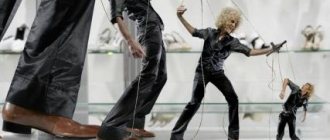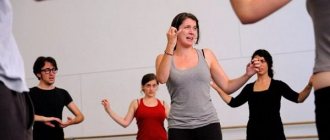People have many statuses and belong to many social groups, the prestige of which in society is not the same. A person looks at the world and treats other people in accordance with his status. The more social roles an individual is able to reproduce, the more adapted to life he is. Thus, the process of personality development often acts as the dynamics of mastering social roles.
A person interacts with different people and social groups every day. It rarely happens that he fully interacts only with members of one group, for example a family, but at the same time he can also be a member of a work collective, public organizations, etc. Entering simultaneously into many social groups, he occupies the corresponding position in each of them. position determined by relationships with other members of the group. To analyze the degree of inclusion of an individual in various groups, as well as the positions he occupies in each of them, the concepts of social status and social role are used.
Status (from Latin status - position, condition) - the position of a citizen.
Social status is usually defined as the position of an individual or group in a social system, which has characteristics specific to this system. Each social status has a certain prestige.
All social statuses can be divided into two main types: those that are prescribed to the individual by society or a group, regardless of his abilities and efforts, and those that the individual achieves through his own efforts.
Variety of statuses
There is a wide range of statuses: prescribed, achieved, mixed, personal, professional, economic, political, demographic, religious and consanguineous, which belong to the variety of basic statuses.
In addition to them, there are a huge number of episodic, non-main statuses. These are the statuses of a pedestrian, passer-by, patient, witness, participant in a demonstration, strike or crowd, reader, listener, television viewer, etc. As a rule, these are temporary states. The rights and obligations of holders of such statuses are often not registered in any way. They are generally difficult to detect, say, in a passerby. But they exist, although they influence not the main, but the secondary traits of behavior, thinking and feeling. Thus, the status of a professor determines a lot in the life of a given person. What about his temporary status as a passerby or a patient? Of course not.
So, a person has basic (determining his life activity) and non-basic (affecting the details of behavior) statuses. The first are significantly different from the second.
Behind each status - permanent or temporary, basic or non-basic - there is a special social group or social category. Catholics, conservatives, engineers (main statuses) form real groups. For example, patients, pedestrians (non-primary statuses) form nominal groups or statistical categories. As a rule, holders of non-main statuses do not coordinate their behavior with each other in any way and do not interact.
People have many statuses and belong to many social groups, the prestige of which in society is not the same: businessmen are valued higher than plumbers or general workers; men have more social “weight” than women; belonging to a titular ethnic group in a state is not the same as belonging to a national minority, etc.
Over time, public opinion is developed, transmitted, supported, but, as a rule, no documents record a hierarchy of statuses and social groups, where some are valued and respected more than others.
A place in such an invisible hierarchy is called rank , which can be high, medium or low. Hierarchy can exist between groups within the same society (intergroup) and between individuals within the same group (intragroup). And a person’s place in them is also expressed by the term “rank”.
The discrepancy between statuses causes a contradiction in the intergroup and intragroup hierarchy, which arises under two circumstances:
- when an individual occupies a high rank in one group and a low rank in the second;
- when the rights and obligations of one person's status conflict with or interfere with the rights and obligations of another.
A highly paid official (high professional rank) will most likely also have a high family rank as a person who provides material wealth for the family.
But it does not automatically follow from this that he will have high ranks in other groups - among friends, relatives, colleagues. Although statuses do not enter into social relations directly, but only indirectly (through their bearers), they mainly determine the content and nature of social relations.
A person looks at the world and treats other people in accordance with his status. The poor despise the rich, and the rich disdain the poor. Dog owners do not understand people who love cleanliness and order on their lawns. A professional investigator, although unconsciously, divides people into potential criminals, law-abiding and witnesses. A Russian is more likely to show solidarity with a Russian than with a Jew or Tatar, and vice versa.
Political, religious, demographic, economic, professional statuses of a person determine the intensity, duration, direction and content of social relations of people.
Role (French role) is an image embodied by an actor.
A social role is the behavior expected of someone who has a certain social status. Social roles are a set of requirements imposed on an individual by society, as well as actions that a person occupying a given status in the social system must perform. A person can have many roles.
Children's status is usually subordinate to adults, and children are expected to be respectful towards the latter. The status of soldiers is different from that of civilians; The role of soldiers is associated with risk and fulfillment of the oath, which cannot be said about other groups of the population. Women have a different status from men and are therefore expected to behave differently than men.
Each individual can have a large number of statuses, and others have the right to expect him to fulfill roles in accordance with these statuses. In this sense, status and role are two sides of the same phenomenon: if status is a set of rights, privileges and responsibilities, then a role is an action within the framework of this set of rights and responsibilities.
The social role consists of:
- from role expectation (expectation) and
- performance of this role (game).
Cultural norms are learned primarily through role learning.
For example, a person who masters the role of a military man becomes familiar with the customs, moral norms and laws characteristic of the status of this role. Only a few norms are accepted by all members of society; the acceptance of most norms depends on the status of a particular individual. What is acceptable for one status is unacceptable for another. Thus, socialization as the process of learning generally accepted ways and methods of actions and interactions is the most important process of learning role behavior, as a result of which the individual truly becomes a part of society.
Let's look at some definitions of social role:
- fixation of a separate position occupied by one or another individual in the system of social relations;
- function, a normatively approved pattern of behavior expected of everyone occupying a given position;
- a socially necessary type of activity and a way of personal behavior that bears the stamp of public evaluation (approval, condemnation, etc.);
- behavior of an individual in accordance with his social status;
- a generalized way of performing a certain social function, when a person is expected to perform certain actions;
- a stable stereotype of behavior in certain social situations;
- a set of objective and subjective expectations (expectations) derived from the socio-political, economic or any other structure of society;
- social function of the individual, corresponding to the accepted ideas of people depending on their status or position in society, in the system of interpersonal relations;
- the system of expectations existing in society regarding the behavior of an individual occupying a certain position in his interaction with other individuals;
- a system of specific expectations towards himself of an individual occupying a certain position, i.e. how he represents the model of his own behavior in interaction with other individuals;
- open, observable behavior of an individual occupying a certain position;
- an idea of the prescribed pattern of behavior that is expected and required from a person in a given situation;
- prescribed actions characteristic of those who occupy a certain social position;
- a set of norms that determine how a person of a given social status should behave.
Thus, a social role is interpreted as an expectation, activity, behavior, idea, stereotype, social function, and even a set of norms. We consider the social role as a function of the social status of the individual, realized at the level of social consciousness in expectations, norms and sanctions in the social experience of a particular person.
Types of social roles
The types of social roles are determined by the variety of social groups, types of activities and relationships in which the individual is included.
Depending on social relations, social and interpersonal social roles are distinguished. Social roles are associated with social status, profession or type of activity (teacher, student, student, salesperson). These are standardized impersonal roles, built on the basis of rights and responsibilities, regardless of who plays these roles. There are socio-demographic roles: husband, wife, daughter, son, grandson... Man and woman are also social roles, biologically predetermined and presupposing specific modes of behavior, enshrined in social norms and customs.
Interpersonal roles are associated with interpersonal relationships that are regulated at the emotional level (leader, offended, neglected, family idol, loved one, etc.)
In life, in interpersonal relationships, each person acts in some dominant social role, a unique social role as the most typical individual image, familiar to others. Changing a habitual image is extremely difficult both for the person himself and for the perception of the people around him. The longer a group exists, the more familiar the dominant social roles of each group member become to those around them and the more difficult it is to change the behavior pattern habitual to those around them.
Ways to resolve role conflicts
There are protective mechanisms with the help of which inter-role and intra-role conflicts are resolved.
- Rationalization is a method that hides conflict by searching for the negative aspects of an unattainable social role. For example, an applicant who was unable to enter the university of his dreams explains this by the inadequate requirements of entrance examinations.
- Role separation is a method expressed in the temporary absence of functioning of one social role. For example, a military doctor who is in a hot spot, and from whom problems that have arisen in his family are hidden.
- Role regulation is a way of completely refusing responsibility for an action, shifting the blame to large social groups.
These unconscious and conscious mechanisms allow the individual to avoid the unpleasant consequences of intra-role and inter-role conflicts. So, a person, being a social being, performs different social roles, interacting with different social groups. As a result, conflict situations become inevitable, the competent resolution of which will allow one to successfully implement several social roles at once.
Main characteristics of a social role
The main characteristics of a social role are highlighted by American sociologist Talcott Parsons.
He suggested the following four characteristics of any role. 1. By scale. Some roles may be strictly limited, while others may be blurred. 2. By method of receipt. Roles are divided into prescribed and conquered (they are also called achieved). 3. According to the degree of formalization. Activities can take place either within strictly established limits or arbitrarily. 4. By type of motivation. The motivation can be personal profit, public good, etc.
The scope of the role depends on the range of interpersonal relationships. The larger the range, the larger the scale. For example, the social roles of spouses have a very large scale, since the widest range of relationships is established between husband and wife. On the one hand, these are interpersonal relationships based on a variety of feelings and emotions; on the other hand, relations are regulated by regulations and, in a certain sense, are formal.
The participants in this social interaction are interested in a variety of aspects of each other’s lives, their relationships are practically unlimited. In other cases, when relationships are strictly defined by social roles (for example, the relationship between a seller and a buyer), interaction can be carried out only for a specific reason (in this case, purchases). Here the scope of the role is limited to a narrow range of specific issues and is small.
The way a role is acquired depends on how inevitable the role is for the person. Thus, the roles of a young man, an old man, a man, a woman are automatically determined by the age and gender of a person and do not require special efforts to acquire them. There can only be a problem of compliance with one’s role, which already exists as a given. Other roles are achieved or even won during the course of a person's life and as a result of targeted special efforts. For example, the role of a student, researcher, professor, etc. These are almost all roles related to the profession and any achievements of a person.
Formalization as a descriptive characteristic of a social role is determined by the specifics of interpersonal relationships of the bearer of this role. Some roles involve the establishment of only formal relationships between people with strict regulation of rules of behavior; others, on the contrary, are only informal; still others may combine both formal and informal relationships.
It is obvious that the relationship between a traffic police representative and a traffic rule violator should be determined by formal rules, and relationships between close people should be determined by feelings. Formal relationships are often accompanied by informal ones, in which emotionality is manifested, because a person, perceiving and evaluating another, shows sympathy or antipathy towards him. This happens when people have been interacting for a while and the relationship has become relatively stable.
Motivation depends on the needs and motives of a person. Different roles are driven by different motives. Parents, caring for the well-being of their child, are guided primarily by a feeling of love and care; the leader works for the sake of the cause, etc.
Status personality set
Status set of personality
This is a set of status positions.
One and the same person can simultaneously be a son, a husband, a Russian citizen and a military serviceman. Within the framework of a personality’s status set, the following components are distinguished:
- prescribed status - the status we receive from the moment we are born. It includes everything related to innate characteristics (gender, nationality);
- achieved status - a status acquired by a person as a result of efforts or a successful combination of circumstances (spouse, surgeon);
- mixed status - a status that has signs of being prescribed and achieved, that is, one that a person did not receive at the time of birth and not at his own request (unemployed, disabled due to a car accident);
- main status. In modern society, it is most often determined by the professional field in which a person is involved, or his main occupation (Nobel Prize winner).






